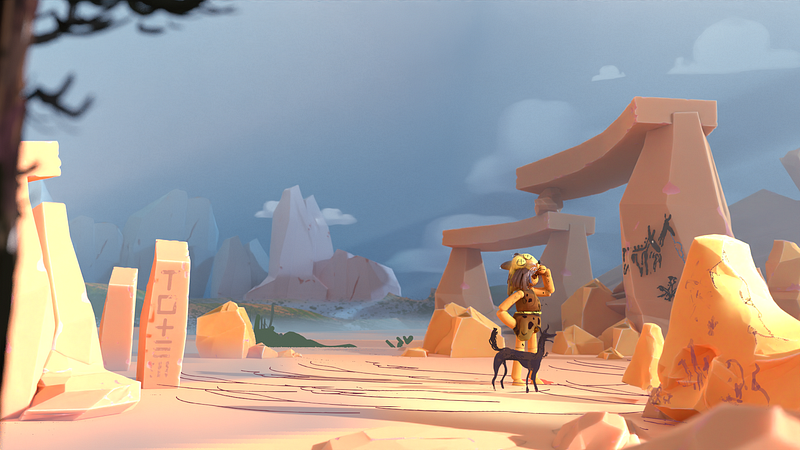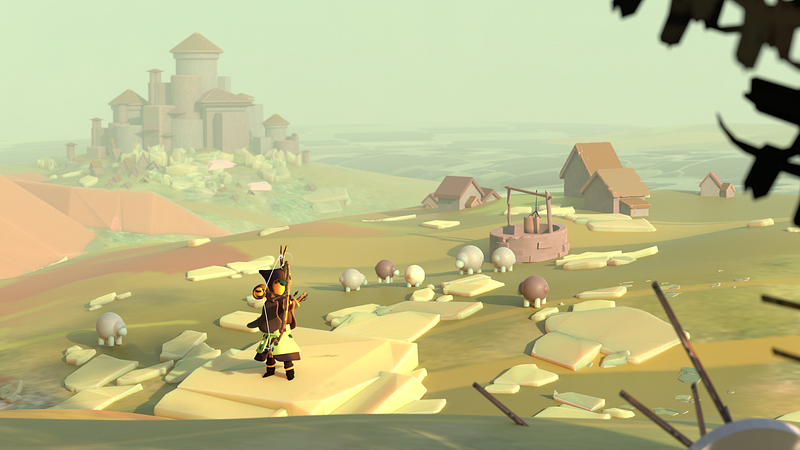A Short Guide to Legacy Events
Idan Rooze | July 2022
Between June 24–30 we held the first Totem Legacy Jam, a global online game jam where five teams created five different interconnected games based on the theme “Circular History”.
Unlike other game jams, the teams were involved with each other’s game production as they had to connect them through Legacy Events — memory elements unique to the Totem Platform that allow players to carry the consequences of their actions from game to game.

A new way to tell stories. Art by Alon Sharabi and Michal Hamzani.
What will the future bring? Art by Alon Sharabi and Michal Hamzani.
So how was this achieved?
Legacy Events allow for communication between game creators by enabling them to publish legacy events from their own game, and read legacy events from other games. All of the events are tied to specific player-owned assets. For example, after collecting enough meat in Game A, a player would be able to negotiate with a boss in Game B, instead of having to fight him.
As the event organizer, as well as a participant, I had insight into the development process of all of the teams and noticed a few approaches to utilizing the Legacy Events. I will separate reading and publishing, as those are two different parts of collaborating through Totem Legacy Events.
Publishing Legacy Events
Publishing is the part where game creators get to decide on a moment in the game that other developers can use, putting it in the spotlight by marking the special occasion on a player-owned asset. This is the aspect that other games are going to interpret, so it’s your chance to highlight the unique elements in your design. Note that these events are permanent — each item “carries” this memory from this game forever.

Every gameplay moment can have a meaning. Art by Alon Sharabi and Michal Hamzani.
I noticed four different approaches for publishing legacy events:
- Progression — Publish when the player manages to cross a certain stage in the game to mark the completion of important milestones in the experience.
Examples: Finishing a game chapter. Completing a secret side-quest. Beating the game. - Skill — Publish when the player managed to accomplish a difficult feat to stress mastery and practice.
Examples: Reaching a high score. Finishing a game run without using any healing. - Choice — Publish when the player is making a meaningful decision to feature important decision-making and highlight a character’s morals.
Examples: Siding with a specific character in an argument. Murdering an innocent bystander for the greater good. - Playstyle — Publish when the player is using a certain approach to solving a problem to focus on the use of different playstyles and creativity.
Examples: Utilizing sniper-type weapons. Approaching combat in a sneaky manner. Using tank-type characters.
The categories are useful to understand what values you are measuring and contributing to an asset’s legacy, which will be used by other creators in their games through reading.
Reading Legacy Events
Reading legacy events of other games allows you to connect and interact with them. In a way, your game latches onto the “hooks” other creators put out there. It allows you to affect player-owned assets (like Avatar, weapons, etc.) in different ways based on their history. Those effects can be broadly categorized into four domains: Mechanics, Cosmetics, Meta, and Easter Eggs, which we call the Totem Game Design Pillars.

Connect your game to other games that inspire you. Art by Alon Sharabi and Michal Hamzani.
Here are a few ways to tie them into past player experiences using Legacy Events, and allowing players to carry the consequences of their actions between other games and yours:
- Mechanics — When a player’s asset goes through a certain Legacy Event you can alter its functionality.
Example: After beating the haunted manor level (Progression Event) in some game, a player’s Weapon receives a unique special power in your game that allows them to deal extra damage to specter enemies. - Cosmetics — When a player’s asset goes through a certain Legacy Event in another game, you can alter the way it looks in yours.
Example: After deciding to side with the planet natives (Choice Event) in an adventure game, you receive their special emblem that will show up on your cloak in your platformer game. - Meta — When a player’s asset goes through a certain Legacy Event in another game, you can unlock or alter your game content accordingly.
Example: After successfully infiltrating five enemy bases quietly (Playstyle Event) in some open-world game, you are granted access to the secret thieves guild hideout in your role-playing game. - Easter Eggs — When a player’s asset goes through a certain Legacy Event in some game, you can provide the player with simple feedback acknowledging the occasion in your game.
Example: After managing to beat a boss without taking any damage (Skill Event) in a deckbuilding game, the townsfolk start referring to you as “the untouchable” in your roguelite game.
Expanding Game Design Space
What does it mean to play in a world where your actions can have consequences in games that haven’t even come out yet? Players’ actions and decisions in Totem games have an everlasting impact on their characters, equipment, and other in-game assets. This new mindset can alter the way they think and act, deepening their connection to the game worlds you create.

What will the future bring? Art by Alon Sharabi and Michal Hamzani.
This has been a short delve into the world of collaborative game creation through Legacy Events. Hopefully, you’re already thinking about ways to incorporate Legacy Events in your next game!